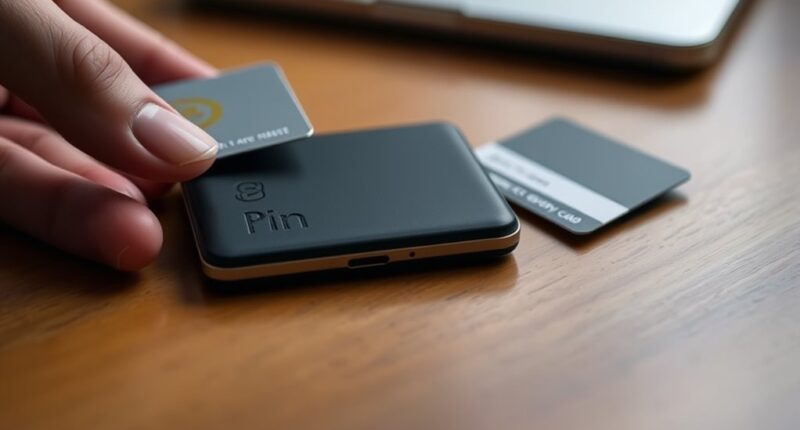To secure your crypto with hardware wallets, always purchase from trusted sources to prevent tampering. Set a strong PIN and generate a recovery seed offline, keeping it in a safe spot. Enable two-factor or multi signature authentication to add extra protection. Regularly update the device’s firmware and avoid sharing sensitive info. Combining these steps with insurance options gives you extensive security. Keep exploring to discover even better ways to safeguard your digital assets.
Key Takeaways
- Store private keys offline in a hardware wallet to prevent hacking and unauthorized access.
- Create and securely store a recovery seed offline for asset recovery if the device is lost or damaged.
- Regularly update firmware and verify the device’s legitimacy to protect against security vulnerabilities.
- Use multi signature authentication to require multiple approvals for transactions, enhancing security.
- Keep backups of recovery seeds and consider insurance options for comprehensive long-term asset protection.

If you’re serious about protecting your cryptocurrency investments, using a hardware wallet is one of the smartest choices you can make. Unlike online wallets or exchanges, hardware wallets store your private keys offline, making them highly resistant to hacking attempts. This physical device acts as a secure vault, guaranteeing your assets stay safe even if the rest of your digital infrastructure is compromised. To add an extra layer of security, many hardware wallets support multi signature authentication, which requires multiple approvals before any transaction can be processed. This setup considerably reduces the risk of unauthorized transfers, even if one of your devices or keys is compromised. In addition, some providers now partner with cryptocurrency insurance services, offering coverage that protects your holdings against theft or loss. While no security measure is foolproof, combining hardware wallets with cryptocurrency insurance provides peace of mind and a thorough safeguard.
When it comes to setting up your hardware wallet, you want to follow best practices meticulously. Start by purchasing directly from the manufacturer or a trusted reseller to avoid tampered devices. Once you receive your hardware wallet, initialize it by creating a strong, unique PIN. During this setup, you’ll generate a recovery seed—this is a vital backup that can restore your funds if the device is lost or damaged. Store this seed securely offline, preferably in a safe or safety deposit box, and never share it with anyone. Enabling multi signature authentication adds another layer of security; it requires multiple private keys stored on different devices or locations for executing transactions. This way, even if someone gains access to one key, they can’t move your funds without the additional approvals.
Furthermore, regularly updating your hardware wallet’s firmware is essential, as updates often patch security vulnerabilities. Be cautious about phishing attempts that try to trick you into revealing your recovery seed or PIN—always verify you’re interacting with legitimate hardware wallet interfaces. For added security, consider integrating multi signature authentication with your hardware wallet setup, which makes it exponentially harder for hackers to hijack your assets. Some advanced wallets also support cryptocurrency insurance options, giving you an added layer of financial protection in case of unforeseen theft. Developing an understanding of inner wisdom and intuitive decision-making can help you better recognize security threats and avoid risky practices. By combining these measures—using a hardware wallet, enabling multi signature authentication, maintaining secure backups, and considering insurance—you create a resilient defense against theft, hacking, and accidental loss. The effort you put into securing your crypto today guarantees your investments remain safe and accessible for the long term.
Frequently Asked Questions
Can Hardware Wallets Be Hacked Remotely?
Hardware wallets can’t be hacked remotely if you follow best practices, but they’re not completely invulnerable. Remote hacking is unlikely, but it’s possible if hackers exploit vulnerabilities in firmware updates or trick you into installing malicious software. To stay safe, always keep your firmware updated from official sources and avoid clicking suspicious links. With proper security measures, you can markedly reduce the risk of remote hacking.
What Is the Lifespan of a Hardware Wallet?
Did you know that most hardware wallets last around 5 to 10 years? You can generally expect good hardware durability within this timeframe, but it varies by brand. The lifespan depends on usage, handling, and environmental factors. Many devices come with a device warranty, often covering repairs or replacements if they fail prematurely. To maximize lifespan, handle your wallet carefully and keep it in a safe, dry place.
Are Hardware Wallets Compatible With All Cryptocurrencies?
Hardware wallets aren’t compatible with all cryptocurrencies, but many support a wide range of options, enhancing your cryptocurrency diversity. You should check each wallet’s hardware wallet compatibility to make certain it supports your preferred coins and tokens. Popular wallets like Ledger and Trezor offer extensive cryptocurrency support, making it easier for you to securely manage multiple assets. Always verify compatibility before purchasing to maximize your crypto security and flexibility.
How Do I Recover My Funds if I Lose My Hardware Wallet?
Losing your hardware wallet is like misplacing a treasured key—your funds could be locked away forever. But don’t panic; backup procedures and recovery options save the day. You should have a seed phrase stored securely offline, ready to restore your wallet on a new device. Always keep your recovery seed safe, because with proper backup procedures, you can recover your funds quickly and confidently, no matter what happens.
Is It Safe to Buy Used Hardware Wallets?
Buying used hardware wallets isn’t totally safe because of risks like digital theft and counterfeit devices. You might unknowingly purchase a compromised or tampered wallet, which could expose your crypto to theft. To protect yourself, buy directly from reputable sources or the manufacturer. Always verify the device’s authenticity and reset it before use. Doing so minimizes the chances of falling victim to counterfeit devices or digital theft.
Conclusion
Now that you know how to secure your crypto with hardware wallets, the real test begins. Will you leave your digital assets vulnerable or take control of your financial future? Remember, a single mistake could cost you everything. The choice is yours—are you ready to protect what’s yours? Stay vigilant, stay prepared, and don’t let complacency be your downfall. Your crypto’s safety depends on the steps you take today.









